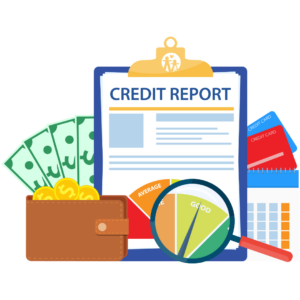The Ultimate Guide to Checking Your Credit Report for Errors
 Your credit report is a critical tool that lenders, landlords, and potential employers use to evaluate your financial responsibility. It provides a snapshot of your credit history, payment history, credit utilization, and any outstanding debts. Monitoring your credit report is an essential practice for maintaining good financial health. However, errors on your credit report can happen and negatively impact your credit score. In this guide, we’ll walk you through checking your credit report for errors and what steps to take if you find any discrepancies.
Your credit report is a critical tool that lenders, landlords, and potential employers use to evaluate your financial responsibility. It provides a snapshot of your credit history, payment history, credit utilization, and any outstanding debts. Monitoring your credit report is an essential practice for maintaining good financial health. However, errors on your credit report can happen and negatively impact your credit score. In this guide, we’ll walk you through checking your credit report for errors and what steps to take if you find any discrepancies.
Step 1: Obtain Your Credit Report
The first step in checking your credit report is to obtain a copy from one or more of the major credit bureaus: Equifax, Experian, and TransUnion. By law, you’re entitled to one free copy of your credit report from each bureau every 12 months through AnnualCreditReport.com.
Step 2: Review Your Credit Report Thoroughly
Check your credit report for errors and inaccuracies. Make sure all information is accurate and up-to-date. Pay close attention to the following:
- Personal Information: Check for misspellings, incorrect addresses, or inaccurate social security numbers.
- Accounts: Review all the accounts listed on your credit report to ensure they belong to you. Look for any accounts you don’t recognize or that are listed as open when they should be closed.
- Payment History: Check that all of your payments are accurately reported. Look for any late payments that you believe need to be corrected.
- Credit Inquiries: Make sure that all of the credit inquiries listed on your report are ones that you authorized. Unauthorized inquiries could be a sign of identity theft.
Step 3: Dispute Any Errors
If you find any errors or inaccuracies on your credit report, it’s essential to take action to correct them. Under the Fair Credit Reporting Act (FCRA), you have the right to dispute any inaccurate information on your credit report.
- Write a Dispute Letter: Start by writing a letter to the credit bureau(s) to report the inaccurate information. In your letter, identify the error and provide any supporting documentation that you have. Be sure to include your name, address, social security number, and account number(s) associated with the error.
- Contact the Creditor: In some cases, the error may be due to a mistake made by the creditor rather than the credit bureau. If this is the case, contact the creditor directly to report the error and request that they update their records.
- Follow-Up: After you submit your dispute, the credit bureau has 30 days to investigate and respond to your claim. Follow up if you are still waiting to hear back within this timeframe.
Step 4: Monitor Your Credit Regularly
Even after you’ve disputed and corrected any errors on your credit report, it’s essential to continue monitoring your credit regularly. Set up account alerts or use a credit monitoring service to be alerted to any changes to your credit report. This way, you can quickly catch and address any future errors.
Checking your credit report for errors is vital to maintaining good financial health. By reviewing your report thoroughly, disputing any inaccuracies, and monitoring your credit regularly, you can ensure that your credit history remains accurate and up-to-date. Maine Family FCU offers SavvyMoney, a free service within Home Banking and Mobile Banking, that allows members to monitor their credit report and credit score.